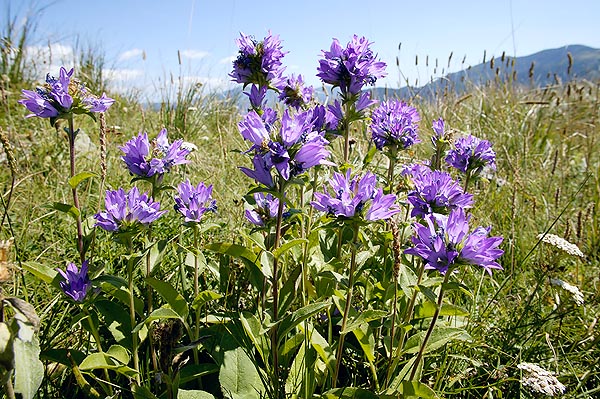Family : Campanulaceae
Text © Alessandro Bordin

English translation by Mario Beltramini

Flowers united in clusters. Excellent for rocky gardens © Giuseppe Mazza
Common name : Clustered bellflower.
Scientific name : Campanula glomerata L. (1753).
Subspecies : the remarkable phenotypical variety, either for what concerns the pilosity of the plant, or the aspect or the presence of lateral flower heads, has caused the identification of several subspecies (i.e. glomerata, serotina, farinose, cervicarioides, etc.).
Phytogeographic type : Eurasian.
Habitat : dry meadows, under brushes, borders of woods. For what the rocky substratum is concerned, it is an indifferent plant, even if it prefers calcareous rocks. It can be found at an altitude between 0 and 1.500 metres.
Flowering : June-September.
Brief description : Perennial plant. Stem : upright, (tall up to 70 cm), hairy or sub-glabrous, not ramified. Lower leaves : oblanceolate-spatulate, with presence of dentils on the margin and truncate or heart-shaped base. Caulinar leaves : alternate, amplexicaul, triangular heart-shaped. Flowers : in a terminal glomerule, some subspecies show also flowers isolated, or united in fascicles on the upper part of the stem. Calyx : with triangular tube and teeth. Corolla : tube and lacinias (5), of lilac or lilac tending colour (seldom white). Fruit : capsule containing many seeds.
Possibility of confusion with other species : none.
Possibility of cultivation : It is sold in many vivaria, very good for rockeries.
Curiosity : the name comes from the Latin diminutive of “campana” = bell, of which it recalls the shape, “glomerata”, on the contrary, refers to the group of the apical flower heads (small bunches).
Synonyms : Campanula farinosa Andrz (1821).
